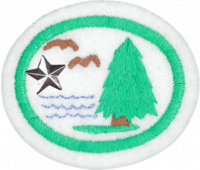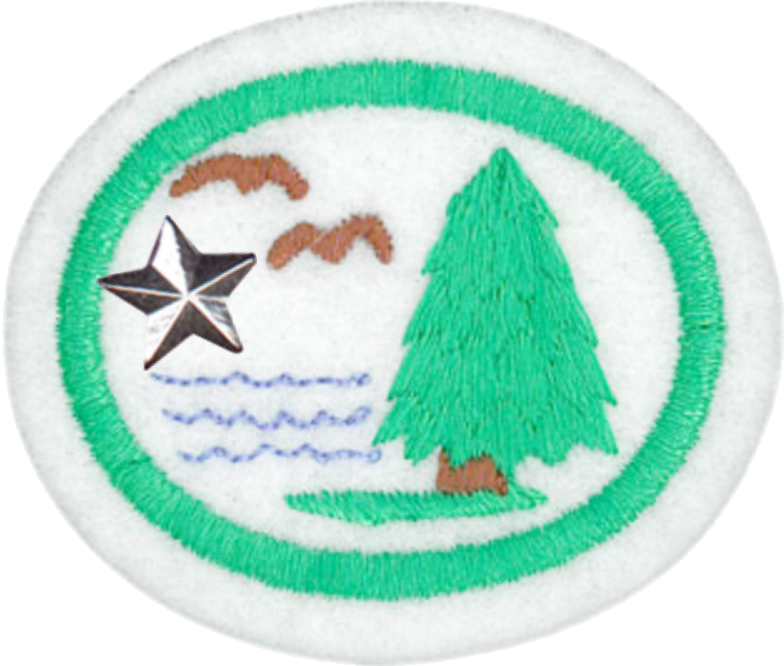Difference between revisions of "AY Honors/Ecology - Advanced/Requirements"
Jomegat bot (talk | contribs) (Bot: Automated import of articles *** existing text overwritten ***) |
(- Category of Honor Requirements) |
||
| (9 intermediate revisions by 2 users not shown) | |||
| Line 1: | Line 1: | ||
| − | + | {{HonorSubpage}} | |
| − | |||
| − | |||
| − | |||
| − | |||
| + | <section begin=Body /> | ||
| − | < | + | <b>1. <section begin=req1 /><noinclude><translate><!--T:1--> |
| − | + | </noinclude>Have the Ecology honor. | |
| − | + | <noinclude></translate></noinclude><section end=req1 /></b> | |
| + | <b>2. <section begin=req2 /><noinclude><translate><!--T:2--> | ||
| + | </noinclude>State the first and second laws of thermodynamics and explain how they are important to ecology. | ||
| + | <noinclude></translate></noinclude><section end=req2 /></b> | ||
| − | < | + | <b>3. <section begin=req3 /><noinclude><translate><!--T:3--> |
| − | + | </noinclude>Explain the three basic trophic (feeding) levels and give a good example of a plant or animal for each. | |
| − | Explain the three basic trophic (feeding) levels and give a good example of a plant or animal for each. | + | <noinclude></translate></noinclude><section end=req3 /></b> |
| + | <b>4. <section begin=req4 /><noinclude><translate><!--T:4--> | ||
| + | </noinclude>Explain or diagram the three types of ecological pyramids in the food web. Give an example of each layer of the pyramid. | ||
| + | <noinclude></translate></noinclude><section end=req4 /></b> | ||
| − | < | + | <b>5. <section begin=req5 /><noinclude><translate><!--T:5--> |
| − | + | </noinclude>Define the biogeochemical cycle, and explain or diagram all the basic components the cycle passes through. | |
| − | + | <noinclude></translate></noinclude><section end=req5 /></b> | |
| + | <b>6. <section begin=req6 /><noinclude><translate><!--T:6--> | ||
| + | </noinclude>Diagram or explain the basic steps in the flow of energy through the biotic environment (element) of an ecosystem. Begin with the sun. | ||
| + | <noinclude></translate></noinclude><section end=req6 /></b> | ||
| − | < | + | <b>7. <section begin=req7 /><noinclude><translate><!--T:7--> |
| − | '' | + | </noinclude>Explain Liebig's Law of The Minimum and Shelford's Law of Tolerance, and state how these laws tell us how and why certain plants and animals become endangered or are eliminated when their habitat or community gets disturbed OR out of balance. |
| − | + | <noinclude></translate></noinclude><section end=req7 /></b> | |
| + | <b>8. <section begin=req8 /><noinclude><translate><!--T:8--> | ||
| + | </noinclude>Choose a biological community in your area, such as a forest or woods; a swamp, lake or pond; pasture or meadow grassland; or a canyon or creek woods, etc., that is disturbed or ecologically out of balance in some way. Make a description of it, including how and to what extent it is disturbed. Then make recommendations as to how the community could be improved and, where possible, follow through and help to improve it in some way. | ||
| + | <noinclude></translate></noinclude><section end=req8 /></b> | ||
| − | + | <section begin=challenge /> | |
| − | + | <b>9. <section begin=req9 /><noinclude><translate><!--T:9--> | |
| − | + | </noinclude>Spend a minimum of 20 hours doing active, productive work on an ecology project in your area. This may be done individually or as a group. Describe the project in general, but report specifically on your part in it. | |
| + | <noinclude></translate></noinclude><section end=req9 /></b> | ||
| + | <section end=challenge /> | ||
| + | <b>10. <section begin=req10 /><noinclude><translate><!--T:10--> | ||
| + | </noinclude>Define the following terms: | ||
| + | <noinclude></translate></noinclude><section end=req10 /></b> | ||
| − | </translate>< | + | :<b>a. <section begin=req10a /><noinclude><translate><!--T:11--> |
| − | + | </noinclude>Community | |
| − | + | <noinclude></translate></noinclude><section end=req10a /></b> | |
| + | :<b>b. <section begin=req10b /><noinclude><translate><!--T:12--> | ||
| + | </noinclude>Raw materials | ||
| + | <noinclude></translate></noinclude><section end=req10b /></b> | ||
| − | </translate>< | + | :<b>c. <section begin=req10c /><noinclude><translate><!--T:13--> |
| − | + | </noinclude>Photosynthesis | |
| − | + | <noinclude></translate></noinclude><section end=req10c /></b> | |
| + | :<b>d. <section begin=req10d /><noinclude><translate><!--T:14--> | ||
| + | </noinclude>Chemosynthesis | ||
| + | <noinclude></translate></noinclude><section end=req10d /></b> | ||
| − | </translate>< | + | :<b>e. <section begin=req10e /><noinclude><translate><!--T:15--> |
| − | + | </noinclude>Autotrophy | |
| − | + | <noinclude></translate></noinclude><section end=req10e /></b> | |
| + | :<b>f. <section begin=req10f /><noinclude><translate><!--T:16--> | ||
| + | </noinclude>Heterotrophy | ||
| + | <noinclude></translate></noinclude><section end=req10f /></b> | ||
| − | </translate>< | + | :<b>g. <section begin=req10g /><noinclude><translate><!--T:17--> |
| − | + | </noinclude>Ecological balance | |
| − | + | <noinclude></translate></noinclude><section end=req10g /></b> | |
| + | :<b>h. <section begin=req10h /><noinclude><translate><!--T:18--> | ||
| + | </noinclude>Saprobe | ||
| + | <noinclude></translate></noinclude><section end=req10h /></b> | ||
| − | </translate>< | + | :<b>i. <section begin=req10i /><noinclude><translate><!--T:19--> |
| − | + | </noinclude>Decomposer | |
| − | + | <noinclude></translate></noinclude><section end=req10i /></b> | |
| + | :<b>j. <section begin=req10j /><noinclude><translate><!--T:20--> | ||
| + | </noinclude>Producer | ||
| + | <noinclude></translate></noinclude><section end=req10j /></b> | ||
| − | </translate>< | + | :<b>k. <section begin=req10k /><noinclude><translate><!--T:21--> |
| − | + | </noinclude>Consumer | |
| − | + | <noinclude></translate></noinclude><section end=req10k /></b> | |
| + | :<b>l. <section begin=req10l /><noinclude><translate><!--T:22--> | ||
| + | </noinclude>Limited factor | ||
| + | <noinclude></translate></noinclude><section end=req10l /></b> | ||
| − | < | + | <b>11. <section begin=req11 /><noinclude><translate><!--T:23--> |
| − | + | </noinclude>Find a Spirit of Prophecy quotation and a Bible text pertinent to ecology and explain their relevance and application to our day. | |
| − | + | <noinclude></translate></noinclude><section end=req11 /></b> | |
| − | + | <section end=Body /> | |
| − | |||
| − | |||
| − | |||
| − | |||
| − | |||
| − | |||
| − | |||
| − | |||
| − | |||
| − | |||
| − | |||
| − | |||
| − | |||
| − | |||
| − | |||
| − | |||
| − | |||
| − | |||
| − | |||
| − | |||
| − | |||
| − | |||
| − | |||
| − | |||
| − | |||
| − | |||
| − | |||
| − | |||
| − | |||
| − | |||
| − | |||
| − | < | ||
| − | : | ||
| − | |||
| − | |||
| − | |||
| − | |||
| − | |||
| − | |||
| − | |||
| − | |||
| − | |||
| − | |||
| − | |||
| − | |||
| − | |||
| − | |||
| − | |||
| − | Find a Spirit of Prophecy quotation and a Bible text pertinent to ecology and explain their relevance and application to our day. | ||
| − | |||
| − | |||
| − | </translate><section end=req11 /> | ||
| − | |||
| − | |||
Latest revision as of 22:10, 20 July 2022
1. Have the Ecology honor.
2. State the first and second laws of thermodynamics and explain how they are important to ecology.
3. Explain the three basic trophic (feeding) levels and give a good example of a plant or animal for each.
4. Explain or diagram the three types of ecological pyramids in the food web. Give an example of each layer of the pyramid.
5. Define the biogeochemical cycle, and explain or diagram all the basic components the cycle passes through.
6. Diagram or explain the basic steps in the flow of energy through the biotic environment (element) of an ecosystem. Begin with the sun.
7. Explain Liebig's Law of The Minimum and Shelford's Law of Tolerance, and state how these laws tell us how and why certain plants and animals become endangered or are eliminated when their habitat or community gets disturbed OR out of balance.
8. Choose a biological community in your area, such as a forest or woods; a swamp, lake or pond; pasture or meadow grassland; or a canyon or creek woods, etc., that is disturbed or ecologically out of balance in some way. Make a description of it, including how and to what extent it is disturbed. Then make recommendations as to how the community could be improved and, where possible, follow through and help to improve it in some way.
9. Spend a minimum of 20 hours doing active, productive work on an ecology project in your area. This may be done individually or as a group. Describe the project in general, but report specifically on your part in it.
10. Define the following terms:
- a. Community
- b. Raw materials
- c. Photosynthesis
- d. Chemosynthesis
- e. Autotrophy
- f. Heterotrophy
- g. Ecological balance
- h. Saprobe
- i. Decomposer
- j. Producer
- k. Consumer
- l. Limited factor
11. Find a Spirit of Prophecy quotation and a Bible text pertinent to ecology and explain their relevance and application to our day.


